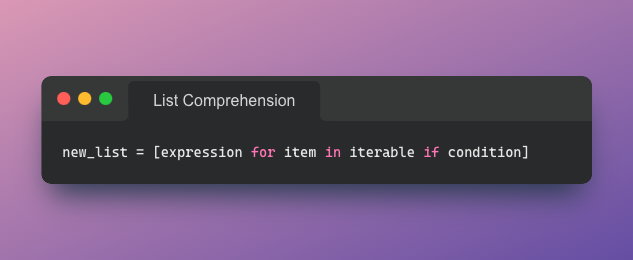What is Python List Comprehension?

Python list comprehension is a concise and expressive way to create lists. It provides a compact syntax for generating new lists by iterating over an existing iterable (like a list, tuple, string, etc.) and applying an expression to each item.
List comprehensions are often used to transform, filter, or combine data elements while creating a new list in a single line of code.
In simple terms, List Comprehension is a shorthand syntax when you want to create a new list from the values of another list.
The basic structure of a list comprehension
new_list = [expression for item in iterable if condition]Here's a breakdown of the components:
expression: This is the operation or transformation that you want to apply to each item in the iterable to generate the elements of the new list.item: This represents the individual elements in the iterable that you are iterating over.iterable: This is the original collection of items you are iterating over (e.g., a list, tuple, string, etc.).condition(optional): You can include an optional condition that filters the items from the iterable. Only items that satisfy the condition will be included in the new list.
Here are a few examples to illustrate how list comprehensions work:
1. Generating a list of squares:
Without using list comprehension:
# without using list comprehension 🙅♂️
numbers = [1, 2, 3, 4, 5]
squares = []
for x in numbers:
squares.append(x**2) #🤮
# Result: squares = [1, 4, 9, 16, 25]Using list comprehension:
# Using list comprehension 💪
numbers = [1, 2, 3, 4, 5]
squares = [x**2 for x in numbers] #👌
# Result: squares = [1, 4, 9, 16, 25]2. Filtering even numbers:
Without using list comprehension:
# without using list comprehension 🙅♂️
numbers = [1, 2, 3, 4, 5, 6, 7, 8, 9]
evens = []
for x in numbers:
if x % 2 == 0:
evens.append(x) #🤮
# Result: evens = [2, 4, 6, 8]Using list comprehension:
# Using list comprehension 💪
numbers = [1, 2, 3, 4, 5, 6, 7, 8, 9]
evens = [x for x in numbers if x % 2 == 0] #👌
# Result: evens = [2, 4, 6, 8]3. Combining two lists:
Without using list comprehension:
# without using list comprehension 🙅♂️
fruits = ["apple", "banana", "cherry"]
colors = ["red", "yellow", "red"]
colorful_fruits = []
for fruit, color in zip(fruits, colors):
colorful_fruits.append(color + " " + fruit) #🤮
# Result: colorful_fruits = ["red apple", "yellow banana", "red cherry"]Using list comprehension:
# Using list comprehension 💪
fruits = ["apple", "banana", "cherry"]
colors = ["red", "yellow", "red"]
colorful_fruits = [color + " " + fruit for fruit, color in zip(fruits, colors)] #👌
# Result: colorful_fruits = ["red apple", "yellow banana", "red cherry"]4. Nested list comprehension (creating a matrix):
Without using list comprehension:
# without using list comprehension 🙅♂️
matrix = []
for i in range(3):
row = []
for j in range(3):
row.append(i * j)
matrix.append(row)
# Result: matrix = [[0, 0, 0], [0, 1, 2], [0, 2, 4]]Using list comprehension:
# Using list comprehension 💪
matrix = [[i*j for j in range(3)] for i in range(3)]
# Result: matrix = [[0, 0, 0], [0, 1, 2], [0, 2, 4]]Summary
List comprehensions offer a concise way to perform common operations on collections, making your code more readable and often more efficient. However, for very complex expressions or conditions, using a regular loop might be more readable and maintainable.
Just remember the below formula and you've got this in your back pocket!
new_list = [expression for item in iterable if condition]Post Tags: